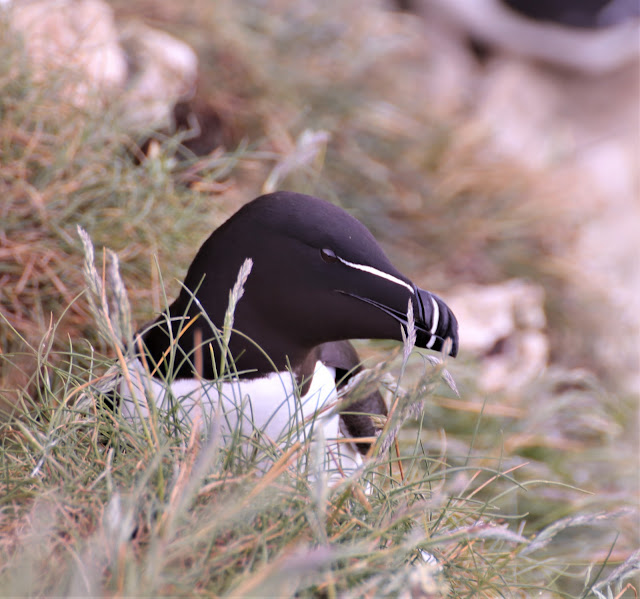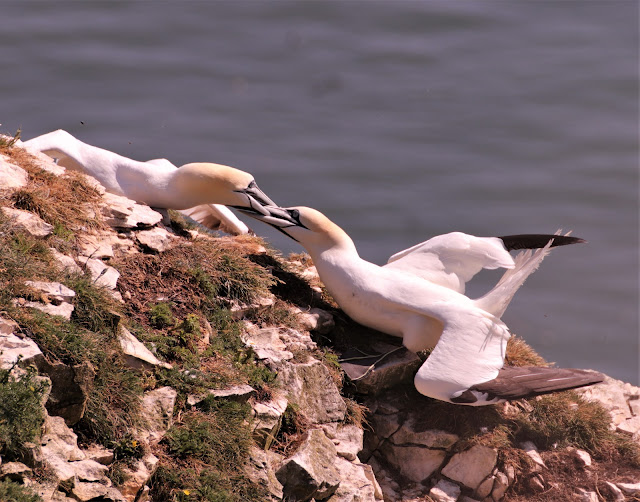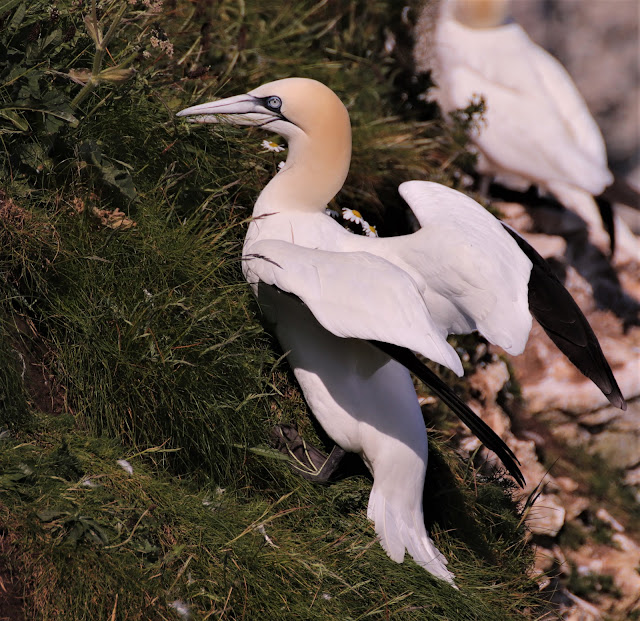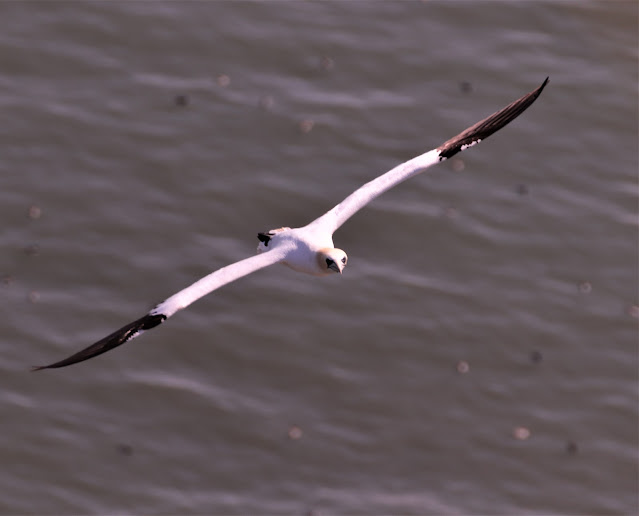While in Leeds (UK) this summer (June) I
visited the art gallery in Roundhay Park and admired a painting by a local
artist, Sonia Taylor. The painting showed puffins flying off a cliff towards
the sea at Bempton Cliffs on the East Coast of England near Bridlington and
Flamborough Head. Sonia told me that this was a good time to visit, to see
puffins and razorbills and various other seabirds.
.JPG) |
Gannet
|
A few days later Miriam and I travelled
to the RSPB Reserve at Bempton Cliffs. There we were overwhelmed by the thousands
of seabirds flying over the sea, swimming in the sea and nesting and resting on
the cliff sides. Several viewing platforms have been positioned on the cliff
edge to give safe places to best see the birds.
.JPG) |
| Bempton Cliffs - Looking North towards Filey |
What a treat we had. There were lots and
lots of kittiwakes, gannets, razorbills, guillemots and herring gulls, but we
couldn’t see the bird that we had really hoped to see, the puffin. It wasn’t
just the sight of so many birds that was so impressive, but the cacophony of bird
calls. We’ve become used to seeing and hearing the impressive sight and sound
of tens of thousands of cranes in Israel in the Hula Valley, but this was our
first experience of this number of birds in England.
Kittiwakes and herring gulls look very
similar – they’re both primarily white birds with a grey rear and black tail-end.
You can tell them apart as the kittiwake has a small yellow bill, a dark eye and
short black legs, whereas the gull is a bigger bird and has pink legs and a red
spot on its beak. But their calls are completely different, the kittiwake calls
out ki-ti-waak, while the gull has a loud typical gull call.
 |
| Herring gull with red spot on beak |
 |
| Kittiwake |
Razorbills are black birds with white
underparts (one has to be careful writing this word, as auto correction software
often changes the word). And their bill, with its distinctive white muzzle-like
markings is, unsurprisingly, razor sharp.
.JPG) |
| Razorbill |
.JPG) |
| Razorbill |
The kittiwakes, gulls and razorbills, as well as guillemots and
gannets massed on the cliff face, squawking and squealing, seemingly oblivious
to our presence. Most, if not all, of the birds were facing towards the cliff
face – you would have thought they would want to enjoy the sea view or even
look out for predators, but actually
predators are few and far between on a cliff face, and I guess they feel safer facing
the cliff than looking out to sea.
Gannets are beautiful birds and big too,
which makes them a little easier to photograph. We watched as several pairs
showed affection to each other, with outstretched necks craning upwards facing and
touching each other. In a similar courtship ‘dance’ we watched gannets lock
bills with each other, in such a way that, at first, we thought they were fighting.
.JPG) |
| Gannets "fencing" or "billing" - a friendship greeting |
.JPG) |
| Gannet - courtship dance |
.JPG) |
| Gannet in flight |
The viewing platforms were busy and
virtually full with serious birders, with serious binoculars and serious
telephoto lenses on their cameras, for which, no doubt, they had paid serious
money. Some of the lenses were at least as long as my arm, and made my 300mm
zoom look insignificant. Amongst the hurly-burly of all these twitching
birders, it was difficult to get my camera in a good position. But then one of
the rangers, who all seemed to be real experts on every aspect of the life of
these birds, called out “barn owl over the field”. All lenses changed direction
and focused on the snowy-white barn owl, flying about 70 or 80 meters away.
This made room for me to get a good position on the viewing platform. I shall remember
what to shout out next time I can’t get a good place on a viewing platform.
On the way back to the visitor centre, I
stopped next to some folk who had their bins trained on the cliff edge and they
were excitedly pointing out to each other the location of a solitary puffin. it
was quite some way off but I managed to get a pic of the wonderful little bird.
I’d never seen a puffin before, aside from the Puffin story books I’d had as a
child - but that’s another story. Apparently, the best time to see puffins is
early in morning or late in the afternoon. During the day they’re out at work –
fishing the seas. So next time, we’ll visit early in the morning; the early
bird catches the early bird.
 |
| Puffin |
While I was photographing the birds,
Miriam spotted a hare ‘tacking’ up the side of a hill. At each change in
direction it stopped and looked around, presumably trying to see where the
tortoise was, or maybe it was looking for Archimedes!
At the visitor centre, manned by more
real experts, we were advised that at nearby Flamborough Head, we’d be able to
see seals. It took about 20 minutes to drive there and indeed we were able to
look down from the cliff top to see scores of seals, on small sand islands
basking in the sun and swimming in shallow waters by the edge of the beach.
 |
| Flamborough Head |
.JPG) |
| Basking seals - looking down from Flamborough Head |
.JPG) |
Basking seals - looking down from Flamborough Head
|
.JPG) |
Basking seals - looking down from Flamborough Head
|
.JPG) |
| Guillemot |
.JPG) |
| Guillemot |
.JPG) |
| Gannets - locking beaks - a friendship greeting |
.JPG) |
| Gannet |
.JPG) |
| Gannet in flight |
.JPG)
.JPG)


.JPG)
.JPG)
.JPG)
.JPG)
.JPG)


.JPG)
.JPG)
.JPG)
.JPG)
.JPG)
.JPG)
.JPG)
.JPG)
.JPG)

-2.jpg)


No comments:
Post a Comment
Note: Only a member of this blog may post a comment.